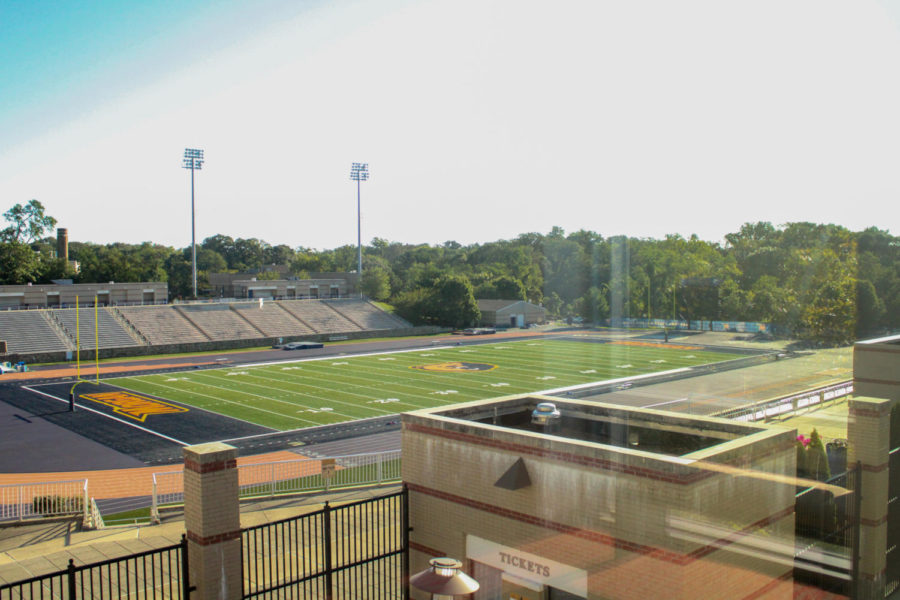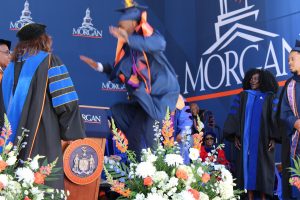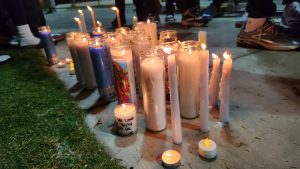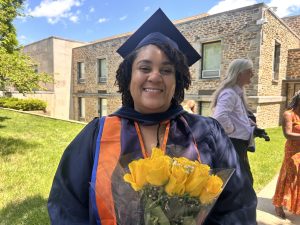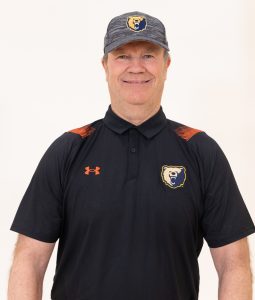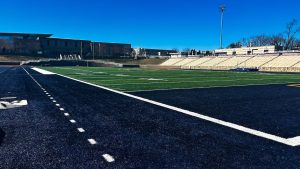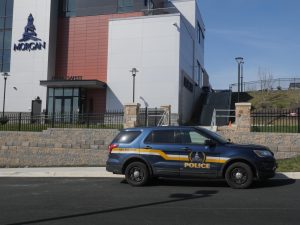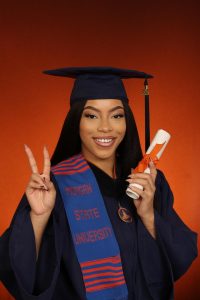Small Schools, Big Dreams: Bowie State Pro Day shines spotlight on NFL prospects
11 athletes including eight HBCU athletes and two Morgan Bears, showcased their skills at Bowie State University’s Pro Day on March 29.
Morgan State University’s Hughes Stadium.
April 24, 2023
Top competitors across college football will hope to hear their name called during the 2023 NFL Draft, slated to take place from April 27 to 29.
However, just one HBCU athlete was selected in the NFL Draft in 2020, none in 2021, and four in 2022.
In effort to get HBCU players recognition, Bowie State University welcomed NFL prospects from four local universities at their Pro Day on campus in Bowie, Maryland, including Morgan State University’s Alfonzo Graham and Myles Wright.
Damon Wilson, head football coach at Morgan, estimated that there were scouts present representing at least seven NFL teams.
These athletes include:
- Quinto Bobo, OL, Bowie State
- Chris Canady, WR, Wheeling
- Tyron Ferguson, LB/LS, Bowie State
- Dion Golatt, Jr., QB, Bowie State
- Alfonzo Graham, RB, Morgan State
- Ellison Jordan, DL, Bowie State
- Isaiah Rainey-Niz, TE/WR, Bowie State
- Morgan Scroggins, WR, Bowie State
- Steven Smothers, WR, Stevenson University
- Kedrick Whitehead, DB, University of Delaware
- Myles Wright, TE/LS, Morgan State
In the 2023 USFL Draft, each of the eight teams selected at least one player from an HBCU. In the 2023 XFL draft, the same was true, with a total of 12 former HBCU athletes drafted to the USFL and 19 to the XFL. Two former HBCU athletes were drafted to the CFL in 2022, both from Tuskegee University.
The road to the NFL Draft begins with the NFL Combine, which was held from Feb. 27 to March 6. Just one HBCU football player (Arkansas-Pine Bluff) was invited to the NFL Combine this year, and four were invited the year prior.
Usually, combine and pro-day training can last from eight to 10 weeks from the end of the athletes’ season to the time of their pro day. This time spent training sets the tone for an athlete’s draft profile. One bad workout can be the difference between a prospect getting the call as a draftee or an undrafted free agent. The top prospects typically invest thousands of dollars into renting out training facilities, such as the facility that Exos makes available to prospects.
In preparation for the professional game, Wright had a difficult time dealing with some trainers. He said, “ So I had like three trainers…and then for the last…two weeks, I was with a whole different trainer… I was doing stuff on my own but like, when you [are] working out for like, combine training that’s a different training than…just working out for football.”
The NFL has actively involved itself in trying to draw more eyes to HBCU athletes. They created the NFL HBCU Combine in 2020, holding it every year minus 2021 due to COVID restrictions.
Two years later in 2022, the NFL alongside the Black College Football Hall of Fame, Pro Football Hall of Fame, and Tulane University created the HBCU Legacy Bowl. It was done to create “opportunity and exposure” for HBCUs and their athletes.
The NFL would go on to pair the HBCU Combine with the HBCU Legacy Bowl, starting in 2023. This year 47 HBCU student-athletes participated in the HBCU combine including Wright, Golatt Jr., and Graham, and 98 were listed on the rosters for the HBCU Legacy Bowl, including running back Graham and Morgan offensive lineman Chris Anthony.
For Wright, the Legacy Bowl was a “good experience” for him and gave him the opportunity to show out against top HBCU prospects.
He said, “Practice, they [HBCU Bowl Organizers] said was the most important part and I was just happy that I was able to go in and compete with the best guys in the HBCU Bowl and do good.”
Wilson, Wright’s head coach, is grateful for the attention the Legacy Bowl has brought overlooked HBCU talent, and looks forward to playing competitive non-conference opponents which he anticipates will also bring more attention to the Morgan Bears.
The Days Events
At the pro day, athletes followed a standard itinerary which included events in the weight room and on the field. The weight room events were height and weight, vertical jump, and bench press; The field events were broad jump, 40-yard dash, the pro agility drill, and then position-specific workouts.
Graham weighed in at 189 pounds and his 5’9 stature has often been likened to that of a slot receiver. His 40-yard dash clocked in at 4.50, and according to Wilson, performed well overall.
According to Graham, what sets him apart from competitors is his ability to bring “home run touchdowns.”
“I can score from anywhere on the field,” Graham said.
Graham, who has met with several NFL teams, doesn’t believe his experience at an HBCU negatively impacted his exposure. “I feel as though if you’re good enough the scouts [will] find you. You just gotta work hard and just be yourself,” he said.
The dual-threat referenced claims that he would likely be an undrafted free agent and felt he’d been underestimated. “That’s great, you know, I want to kick the door down,” Graham said.
Stevenson receiver Smothers has been aware of what it takes to reach the top level for some time now. He was a “four-star recruit” coming out of high school when he committed to West Virginia. He played at Memphis for a season before finishing his college career at Stevenson.
At the pro day, he measured in at 5’9 and 165 pounds but never let his stature get in the way of his ability. His speed is what shows up on the tape and being a “slot receiver” is what scouts look for.
When asked what the biggest skill he brings to the professional game, Smothers said, “My speed, that’s the biggest thing right there as long as you can run fast, you know, people are looking at you, eyes open and doors open… and just me being a slot receiver that’s kind of what the game is going to.”
“It’s about taking advantage of the things you do have”
HBCUs like Morgan have helped prepare athletes for life through both academics and sports, allowing players a platform to showcase their abilities, according to Wilson.
Bowie State wide receiver and tight end Rainey-Nix felt he had the ability to compete at the top level but he was not given the necessary exposure early on. Coming out of high school, he was not given an opportunity by colleges so he had to “be up half the night” contacting schools, vying for an opportunity to apply his trade.
Rainey-Nix said, “Two [or] three weeks before the semester started, I heard from a coach that was really interested in me at a D3 school. So I was like, I still wanna play football so I’ll go.”
He kept reaching out to programs at the Division I level as he felt that’s where his ability lied at. He was diligent with staying in touch with coaches until eventually he was given the opportunity to walk on at the University of Akron. Rainey-Nix finally got his Division I opportunity but it was not what he had hoped it to be.
He said, “ Everything was going good, but then the finances started to catch up with me. I was kind of homeless. So I just decided to come back home… because it’ll be a lot easier for me to commute to a local school rather than trying to figure out where I’m going to sleep at night; when I’m going to get my next meal. So that’s what landed me at Bowie State.
While Rainey-Nix is feeling some of the financial strain relieved, he acknowledges that his tuition was covered by FAFSA (Free Application for Federal Student Aid) and not Bowie State’s football program. He said, “Since I’m instate, my tuition is kind of covered by my FAFSA. So that was a big relief, not just for me but for my family as well.”
Wilson, who is also the former head coach of Bowie football, describes differences in resources between Division I (Morgan) and Division 2 (Bowie) HBCU teams. At Bowie, he says, “resources were a little limited scholarship wise, we weren’t fully funded.”
“Whereas at Morgan, we have the full 63 scholarships, we have the academic support, we have the strength and conditioning support,” he continued.
“It’s about taking advantage of the things that you do have,” said Wilson.“Let’s not focus on what we don’t have, let’s focus on the things that we do have and take advantage of those things.”

